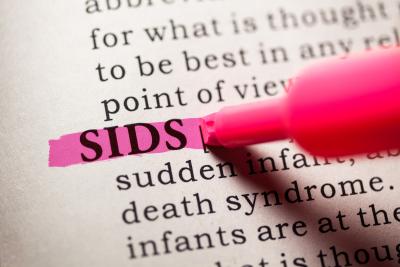Sudden Infant Death Syndrome (SIDS) for Medical Professionals
Sudden Infant Death Syndrome (SIDS) is the sudden death of an infant younger than one year of age that remains unexplained after a thorough case investigation, including performance of a complete autopsy, examination of the death scene, and review of the infant’s and family’s clinical histories.
SIDS facts
- SIDS is the leading cause of death in infants between one month and one year of age in the United States.
- Infants should be placed for sleep in a supine position (wholly on the back) for every sleep by every caregiver until 1 year old. "Since the Back to Sleep campaign started, the percentage of infants placed on their backs to sleep has increased dramatically, and the overall SIDS rates have declined by more than 50 percent."
- There is no research evidence of an increased risk of aspiration or choking related to supine sleep position. Supine sleep is not associated with respiratory symptoms, cyanosis, pallor, or aspiration among infants.
- Infants who are exposed to secondhand smoke after birth are at 2.5 times greater risk for SIDS.
- Find more facts in Appendix A.
Risk-Reduction Recommendations:
Parents may be concerned that the supine sleep position will cause aspiration, be uncomfortable for the infant, or create a flattened skull. Advise patients who may have these concerns with accurate, research-based statements.
Many infant care practices are rooted in cultural tradition and experience. For this reason, risk-reduction recommendations should be delivered in a clear, culturally appropriate manner.
Risk of SIDS can be significantly reduced by implementing the recommendations below. For patient education material, see the Shasta County SIDS page for the general public.
- Back to sleep: Infants should always be placed for sleep in a supine position.
- Use a firm sleep surface: Soft materials should not be placed under a sleeping infant. A firm crib mattress, covered by a sheet, is the recommended sleeping surface.
- A separate but close by sleeping environment is recommended: The risk of SIDS is reduced when the infant sleeps in the same room as the mother but in his/her own crib or bassinet. Infants should not bed share with other children or sleep with anyone on a couch or armchair.
- Keep soft objects and loose bedding out of the crib.
- Pregnant women should receive regular prenatal care.
- Avoid smoke exposure during pregnancy and after birth: Maternal smoking during pregnancy and smoke in the infant’s environment are both risk factors for SIDS. See here for information on quitting.
- Avoid alcohol and illicit drug use during pregnancy and after birth.
- If possible, breastfeeding is recommended. It is best to only breastfeed and not offer formula or other non-human milk-based supplements for 6 months.
- Consider offering a pacifier at nap time and bedtime: Although the mechanism is not known, the reduced risk of SIDS associated with pacifier use during sleep is compelling, and the concern that pacifier use might inhibit breastfeeding or cause later dental complications is not evidence-based. Note: for breastfed infants, delay pacifier introduction until breastfeeding has been firmly established, usually by 3-4 weeks of age.
- Avoid overheating: The infant should be lightly clothed for sleep, and the bedroom temperature should be kept comfortable for a lightly clothed adult.
- Do not use home cardiorespiratory monitors as a strategy for reducing the risk of SIDS: There is no evidence that use of such devices decreases the incidence of SIDS.
- Infants should be immunized in accordance with recommendations of the Centers for Disease Control and Prevention.
- Avoid commercial devices marketed to reduce the risk of SIDS: None have been tested sufficiently to demonstrate efficacy or safety.
- Encourage supervised, awake tummy time to facilitate development and to minimize the risk of positional plagiocephaly.
- Health care professionals, staff in newborn nurseries and NICUs, and child care providers are encouraged to endorse the SIDS risk-reduction recommendations from birth: Model supine sleeping in the NICU as soon as the infant is medically stable, and in the newborn nursery or rooming in with mother as soon as they are ready to be placed in the bassinet. Educate parents about safe-sleeping guidelines upon discharge.
Recommendations from American Academy of Pediatrics: SIDS and Other Sleep-Related Infant Deaths: Expansion of Recommendations for a Safe Infant Sleeping Environment; Pediatrics Volume 128, Number 5, November 2011.

